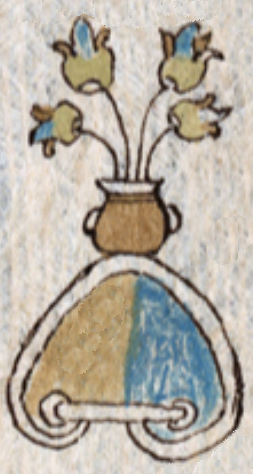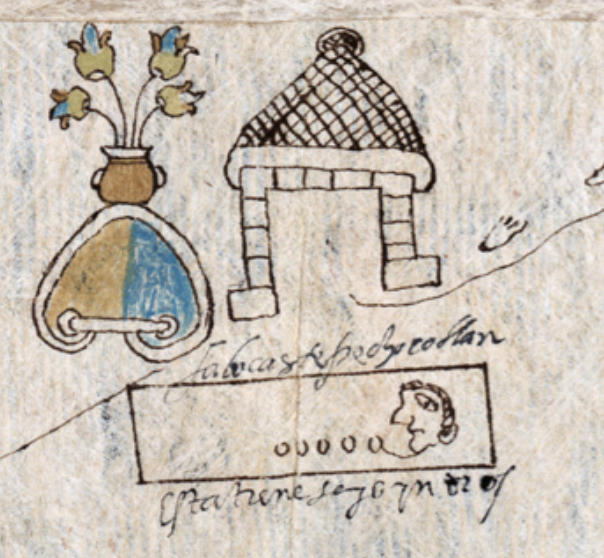Pechxocotlan (RGTyM)
This colorful compound glyph for the place name Pechxocotlan may be "Near a Carpet of Hog Plums." It consists of a brown and white jug (comitl), perhaps filled with green, brown, and blue xocotl flowers. The tepetl (hill or mountain) upon which the jug sits could serve as a silent locative. Interestingly, the hill is divided vertically in half, with the right side a sky blue and the left side brown. A white border surrounds the hill, including a horizontal line at the base.
Stephanie Wood
The phonetic "co" in the name is provided by the comitl, which is redundant if we recognize the flowers as xocotl. The reading of this compound glyph is tentative and calls for further research. The paper has a fold right where the gloss appears, making "fabrica de" and the start of the toponym uncertain.
Stephanie Wood
fabrica de pechxcotlan
Fabrica de Pechxocotlan (?)
Stephanie Wood
1582
Jeff Haskett-Wood
plants, plantas, fruits, frutas, cerámica, cántaros, ollas, hills, cerros, mountains, montañas, nombres de lugares, pueblos, estancias, topónimos, jarras

pech(tli), carpet or flooring, https://nahuatl.wired-humanities.org/content/pechtli
xoco(tl), hog plum, https://nahuatl.wired-humanities.org/content/xocotl
com(itl), ceramic pot or jug, https://nahuatl.wired-humanities.org/content/comitl
-tlan, among, often found as a suffix on place names, https://nahuatl.wired-humanities.org/content/tlan
Cerca del Cerro de los Jocotes
Stephanie Wood
The source of these hieroglyphs is a manuscript and map known collectively as the “Relación de Tistla y Muchitlan,” also known as the “Descripción de la Alcaldia Mayor de las Minas de Zumpango.” Apparently, these towns (today spelled Tixtla and Mochitlan) are in the modern-day state of Guerrero, but they fell under the religious jurisdiction of the Diocese of Tlaxcala. Thanks go to Octavio Márquez for his contribution of the glyph, gloss, and contextualizing images.
The original manuscript is hosted on line as part of the Benson Latin American Collection, The General Libraries, University of Texas at Austin, https://collections.lib.utexas.edu/catalog/utblac:fbc92b3e-bb28-4258-975.... It is open-access.





